An art diary combines personal writing with visual elements to create a unique record of daily life. Anyone can start one with basic supplies like a sketchbook and pens. Daily doodles and quick sketches capture emotions, process feelings, and document ordinary moments in extraordinary ways. This creative practice reduces stress, improves observation skills, and develops an individual artistic style over time. Those small sketches might just reveal the hidden artist within you.
Key Takeaways
- Art diaries blend personal narratives with daily drawing practices to document life experiences and emotional journeys.
- Regular doodling in a visual journal enhances creativity, reduces stress, and promotes mindfulness throughout the day.
- Quality sketchbooks with sturdy pages and versatile art supplies encourage consistent artistic expression.
- Combining imagery with hand-lettering creates a rich personal visual language unique to each journal keeper.
- Daily sketching habits transform ordinary moments into meaningful visual stories while developing your authentic artistic style.
What Is an Art Diary and Why Keep One?
Imagination takes flight in an art diary, a personal visual journal where creativity meets self-reflection. These colorful companions serve as safe havens for thoughts, feelings, and wild ideas that bubble up throughout the day.
Visual diaries aren’t just for professional artists—they’re for anyone who wants to document life’s journey through doodles, collages, or quick sketches.
Why keep one? Art diaries supercharge personal growth by creating a judgment-free zone for artistic expression. They’re like mental playgrounds where mistakes become happy accidents!
When someone flips through their diary pages months later, they often discover patterns in their thinking and amazing improvements in their skills. The daily practice of observing, creating, and reflecting builds mindfulness muscles, helping the brain process experiences in ways that writing alone simply can’t match.
Essential Supplies for Your Visual Narrative Journey
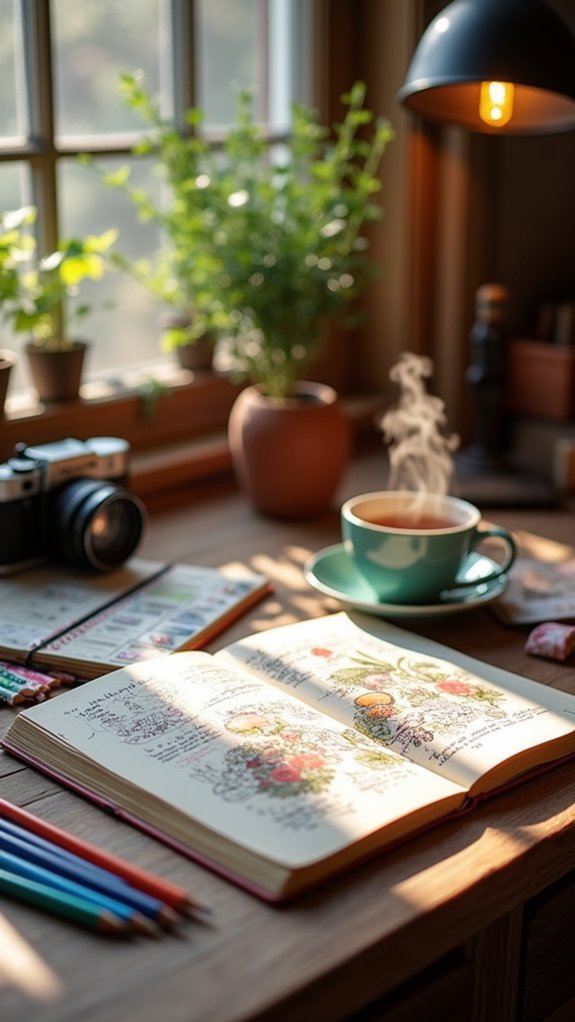
When starting an art diary journey, choosing quality materials for the foundation of your visual storytelling makes a huge difference in both enjoyment and results.
Artists often discover that unexpected items—like old gift cards for spreading paint, dried leaves for texture stamping, or even coffee for staining paper—can become their most treasured creative tools.
Beyond the obvious pens and paints, exploring unconventional supplies opens up exciting possibilities that make each page turn into a surprising adventure of personal expression.
Quality Basics Matter
Although creativity flows from within, the right tools can transform that imaginative energy into stunning visual stories. Investing in quality materials doesn’t mean spending a fortune, but rather choosing items that won’t fall apart after a few uses. A sturdy sketchbook with thick pages prevents bleed-through, while good pens and pencils make creative expression much more enjoyable.
Many beginners in their art journaling practice rush to fancy supplies like glitter and gemstones before mastering the basics. But here’s the truth—you’ll have way more fun with a few excellent tools than a mountain of cheap ones that constantly frustrate you!
Think of your supplies like trusted friends who show up consistently, ready to help turn your wildest ideas into colorful realities on the page.
Unexpected Creative Tools
Beyond the standard art supplies lies a world of unexpected creative tools waiting to transform an ordinary art diary into an extraordinary visual adventure. Artists seeking personal creative expression often discover that everyday items can spark unique mixed media compositions!
| Unexpected Tool | Creative Technique |
|---|---|
| Kitchen sponges | Textured backgrounds |
| Plastic wrap | Watercolor patterns |
| Toothbrushes | Splatter effects |
| Bubble wrap | Stamped impressions |
| Old credit cards | Paint spreading |
These unconventional tools invite experimentation with different techniques that conventional brushes simply can’t achieve. Imagine creating cloud formations with a crumpled paper towel or adding mysterious patterns with string dipped in paint! The beauty of an art diary is that it’s a judgment-free zone where personal exploration trumps perfection. Trying these unexpected tools might just lead to your most exciting artistic discoveries yet!
Finding Your Unique Art Diary Style
Discovering your unique art diary style begins with accepting that personal imperfections actually make your visual narrative authentic and special.
Creating daily drawing habits, even for just five minutes each day, helps build your distinct artistic voice and reveals patterns you might not notice otherwise.
Artists who experiment with different mediums—from watercolors to collage to digital tools—often find unexpected techniques that perfectly express their inner world.
Embrace Personal Imperfection
Freedom lies at the heart of meaningful art journaling, where personal imperfections become treasures rather than flaws. When artists stop worrying about making mistakes, their pages transform into authentic visual narratives that tell real stories. Smudged ink, wobbly lines, and uneven lettering aren’t failures—they’re honest expressions of the human hand.
Creative exploration thrives in this judgment-free zone. Many journal artists report that their most meaningful pages emerged from “happy accidents” or experiments gone sideways. These imperfect moments often lead to breakthrough styles that couldn’t exist through careful planning alone.
Embracing personal imperfection means celebrating what makes each artist unique. After all, if everyone’s art looked perfect and polished, what stories would it tell? The quirks and “mistakes” are precisely what make art diaries personal treasures.
Daily Drawing Habits
The path to personal artistic growth winds through daily practice, much like a garden needs regular tending. Artists who commit to regular drawing sessions discover their visual diaries become treasure troves of daily life moments, creative breakthroughs, and personal reflection opportunities. By setting aside even fifteen minutes each day, anyone can transform scattered thoughts into cohesive visual narratives.
| Time of Day | Activity Type | Benefit |
|---|---|---|
| Morning | Quick sketches | Sets creative tone |
| Afternoon | Observed scenes | Captures daily experiences |
| Evening | Reflective drawing | Processes emotions |
Keeping a portable sketchbook handy invites spontaneous documentation of life’s little wonders—the steam rising from coffee, a stranger’s interesting hat, or a sudden emotional revelation. Looking back through these collections later reveals not just artistic improvement, but also the colorful tapestry of one’s life journey.
Medium Experimentation Journeys
Artists often undertake medium experimentation journeys that transform their visual diaries into playgrounds of possibility. By testing watercolors, acrylics, and even unexpected materials like fabric scraps, creators discover what truly sparks their joy. This exploration isn’t just fun—it’s the path to finding one’s unique artistic voice!
A visual diary becomes the perfect documentation hub, capturing those “aha!” moments when a new technique clicks. Imagine trying collage one day and texture layering the next, each experiment building creative muscles!
When artists hit creative blocks, switching mediums can bust through those walls like artistic superheroes.
Connecting with art communities, whether in-person or online, brings fresh inspiration. Other artists’ techniques can be borrowed, twisted, and transformed into something entirely personal—that’s the magic of artistic expression!
The Therapeutic Benefits of Daily Doodling
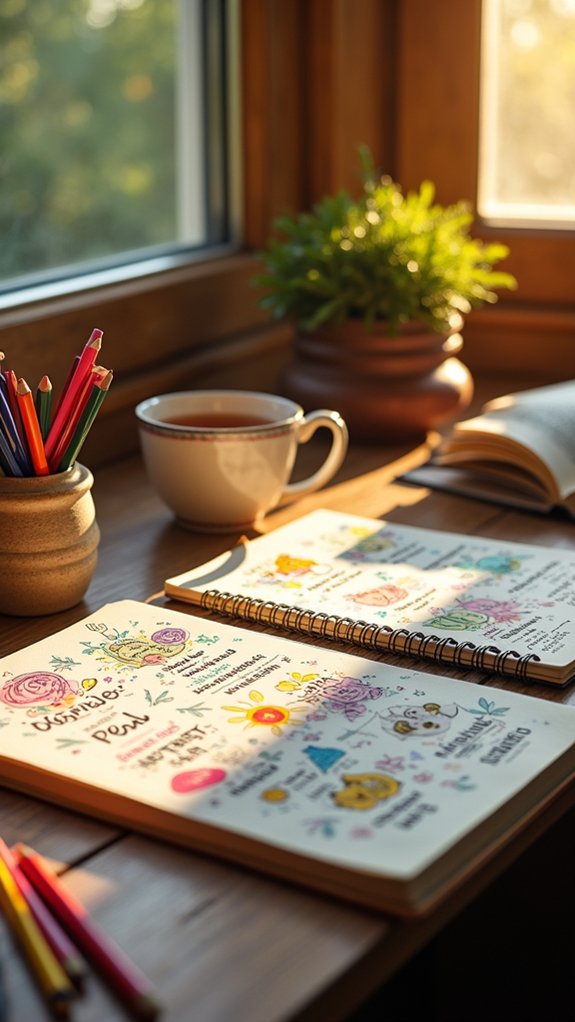
Regularly, people discover that picking up a pen and allowing themselves to doodle can reveal a world of mental health benefits. These simple scribbles and drawings serve as a therapeutic outlet, helping individuals process complex emotions without saying a word.
Like a mini-vacation for the brain, daily doodling reduces stress, calms racing thoughts, and builds emotional resilience.
Research shows that this creative practice isn’t just fun—it’s brain food! Doodlers often remember information better and solve problems more creatively than non-doodlers.
The repetitive motion of making marks on paper creates a meditative state that feels like hitting the reset button on an overloaded mind. For many people, these small artistic moments become emotional lifelines, helping them navigate life’s ups and downs with a steadier hand and clearer perspective.
Capturing Emotions Through Visual Storytelling
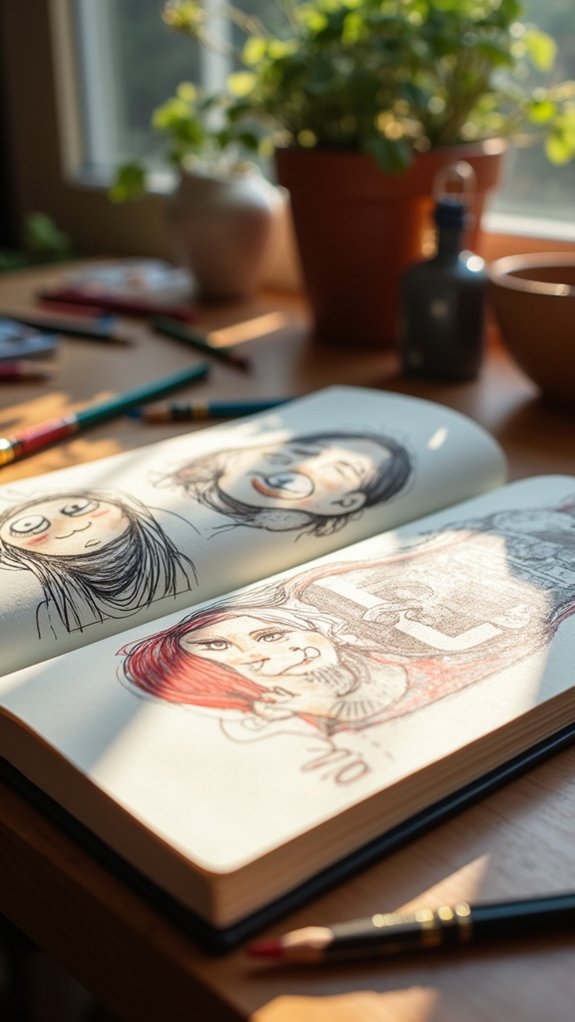
When emotions run too deep for words alone, visual storytelling steps in as a powerful translator of our inner world. Artists discover that symbols, colors, and shapes can express feelings that might otherwise remain bottled up inside.
Through techniques like mood mandalas and color exploration, anyone can begin their art journaling adventure, creating a visual expression of joy, sadness, or anything in between.
Art journaling opens emotional doorways through color and shape, turning our deepest feelings into visible, tangible expressions.
Self-portraits offer a mirror to emotional states, capturing not just appearances but the essence of feelings through facial expressions and posture. Pairing these visuals with reflective writing adds another layer to personal reflection, helping to process complex emotions more fully.
Daily doodles, quick and spontaneous, become emotional breadcrumbs that track feelings over time—creating a rich tapestry of one’s inner scenery that words alone could never capture.
Creating Space for Raw Self-Expression
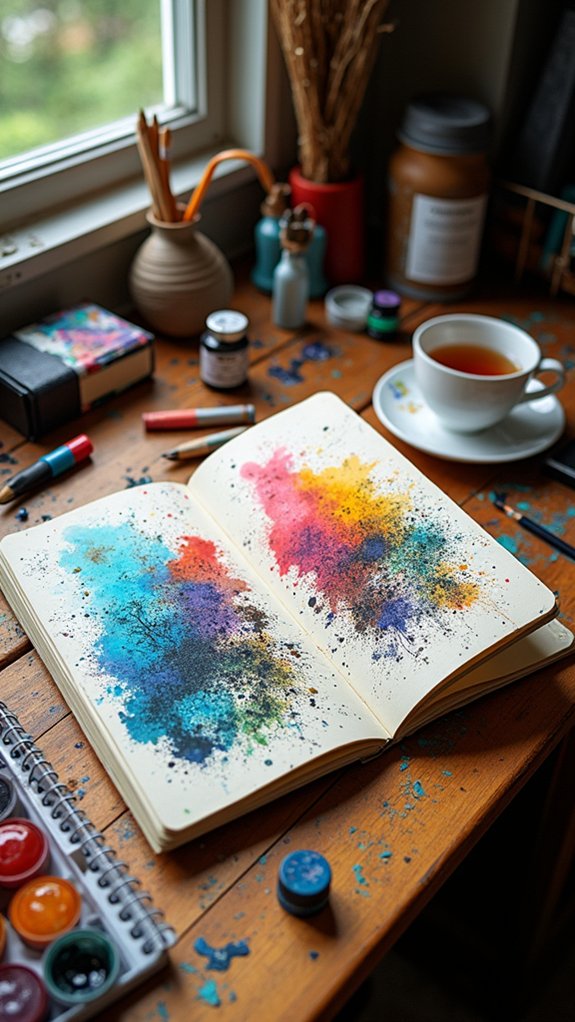
The blank page of an art diary offers something truly magical—a judgment-free zone where thoughts and feelings can spill out without any rules or expectations.
In this personal sanctuary, artists can embrace imperfection, scribble outside the lines, and experiment with artistic techniques that might feel too risky elsewhere.
When someone grabs their markers, paints, or even coffee stains and creates without worrying about “getting it right,” their deepest emotions find a voice.
Teenagers who keep art diaries often discover parts of themselves they never knew existed!
The process isn’t about creating museum-worthy masterpieces; it’s about authentic self-expression that helps make sense of confusing feelings.
Techniques to Blend Words and Imagery
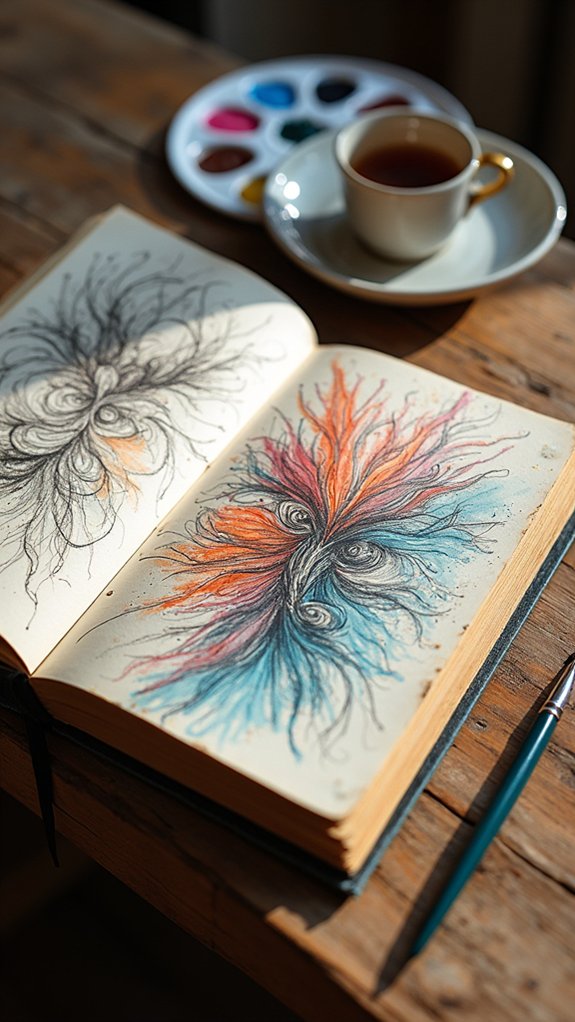
Blending words and imagery creates a visual language that speaks volumes beyond what either element could express alone.
Artists employ various artistic techniques to weave together written thoughts and emotions with visual representation, creating pages that truly sing with personal meaning.
Hand-lettering can transform ordinary quotes into eye-catching focal points, while strategic layout designs—like wrapping text around doodles—invite readers to explore the page.
Elevate your words through artful lettering and thoughtful placement, creating pathways that guide eyes through your creative journey.
Symbols and personal imagery nestled between journal entries add layers of meaning that words alone might miss.
Colors play an essential role too! Choosing blues for calm reflections or fiery reds for passionate thoughts instantly communicates mood.
These techniques turn simple diary entries into rich visual stories where every element—from tiny margin sketches to bold centerpiece illustrations—tells part of your unique tale.
Establishing a Sustainable Art Diary Practice
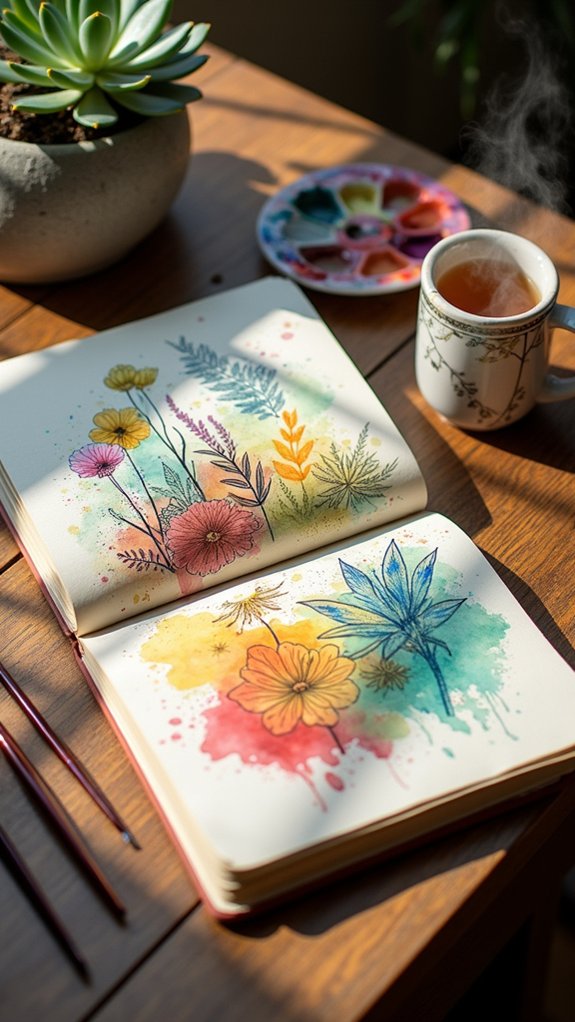
Maintaining an art diary practice doesn’t require fancy supplies or massive time commitments, just thoughtful scheduling and simple habits that stick.
Many artists find success by starting with affordable basics—a sketchbook, some colored pencils, and a few markers—rather than investing in expensive materials that might create pressure to “perform.”
Setting aside just 15 minutes daily, perhaps during morning coffee or right before bed, transforms art journaling from an occasional activity into a natural part of everyday life.
Time Management Tricks
Many artists struggle with finding time for their art diary practice amid busy schedules and competing priorities. Effective time management can transform sporadic creativity into a consistent habit. By experimenting with different approaches, artists can discover what works best for their unique rhythms and lifestyles.
| Strategy | Time Required | Benefits |
|---|---|---|
| Daily timer sessions | 10-15 minutes | Builds focus, prevents procrastination |
| Pre-organized materials | 5 minutes setup | Enables spontaneous creation |
| Weekly theme planning | 20 minutes | Eliminates decision fatigue |
| Task chunking | Varies | Makes big projects manageable |
| Morning mini-sessions | 5-10 minutes | Establishes creative momentum |
Setting a consistent schedule doesn’t mean rigid rules—it means creating space where materials and techniques can be explored without the pressure of time hanging overhead. Even five minutes of doodling counts!
Habit-Building Simplicity
Almost every successful art diary practice begins with simplicity at its core. Starting with small, manageable goals—like one journal page per week—creates momentum without overwhelming the budding artist. When the process feels easy and enjoyable, consistency naturally follows.
Exploring different art techniques keeps the practice fresh and exciting! Try watercolors on Monday, collage on Wednesday, and pencil sketching on Friday. This variety prevents boredom while building artistic skills.
The most meaningful art diaries capture experiences and emotions without requiring perfection. A quick five-minute doodle about feeling anxious, excited, or confused can be more valuable than a detailed masterpiece that takes hours.
Affordable Starter Supplies
When creating an art diary becomes a priority, one needn’t break the bank to get started. A quality sketchbook ($10-$30), some pencils, and basic watercolors or acrylics form the foundation of an affordable artistic practice.
Many beginners find starter kits perfect for experimenting with different mediums without overspending!
Creative artists can boost their supplies by using everyday materials—torn magazine pages make amazing collages, and who knew coffee could create such beautiful stains?
These unconventional techniques add unique textures and depth to diary pages.
For those seeking community support, joining local art groups provides access to shared resources and tons of inspiration.
Why spend money on fancy workshops when fellow artists will happily share their secrets?
The journey of visual storytelling doesn’t require expensive tools—just imagination and a willingness to experiment!
Documenting Life’s Moments Through Quick Sketches
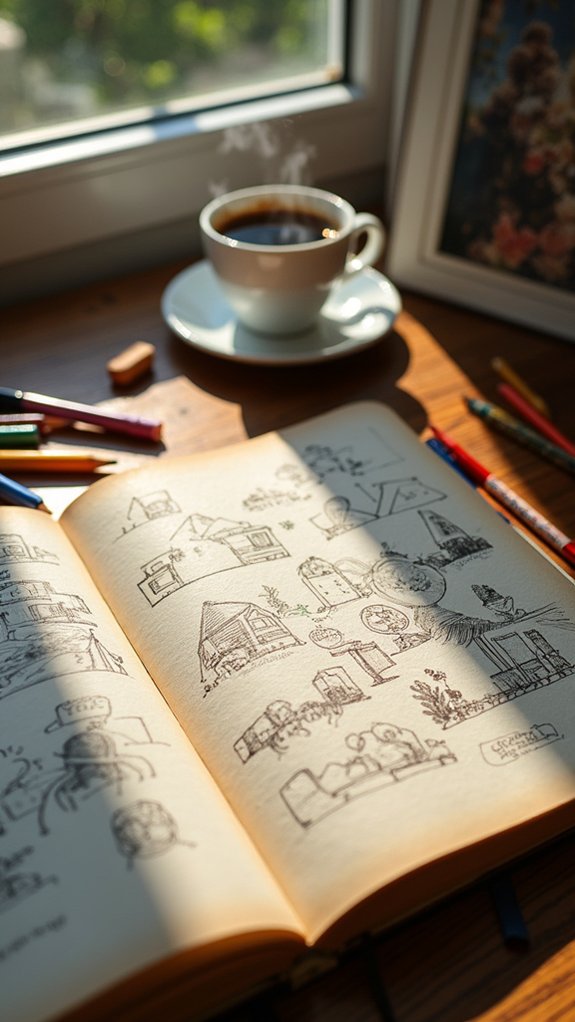
Life’s most memorable moments often slip away before we can fully appreciate them, but quick sketches in an art diary capture these fleeting experiences with surprising power.
The process of creating spontaneous drawings transforms ordinary observations into personal visual stories that can be revisited again and again.
- Grab your pen during morning coffee to document the steam rising from your mug.
- Sketch fellow passengers on your commute to practice capturing human expressions.
- Doodle your lunch before eating it – notice textures and shadows you might miss.
- Record sunset colors with quick washes of watercolor before they fade.
Artists who experiment with different art mediums in their quick sketches often discover unique styles that truly reflect their perspective on the world around them.
Breaking Creative Blocks in Your Visual Journey
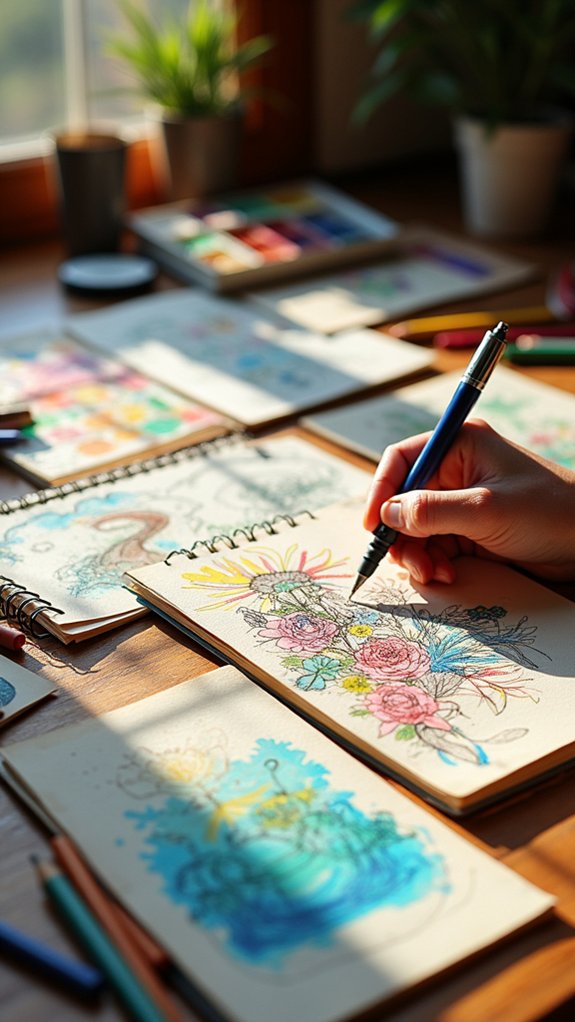
Every artist encounters creative roadblocks that seem impossible to overcome. When art journaling feels stale, changing your environment can work wonders! Stepping outside or moving to a new room refreshes your brain and kickstarts creativity again.
Try limiting yourself to just three supplies for a week—it’s amazing how restriction breeds innovation in visual exploration!
Breaking down your artistic goals into tiny steps (like “draw one flower today”) makes the journey less scary and more fun.
When you’re really stuck, connect with online art journaling communities where fellow creators share their own struggles and solutions.
And remember, sometimes the best thing for your creativity is simply walking away. Taking breaks allows your mind to reset, making room for fresh ideas when you return!
Transforming Mundane Moments Into Art
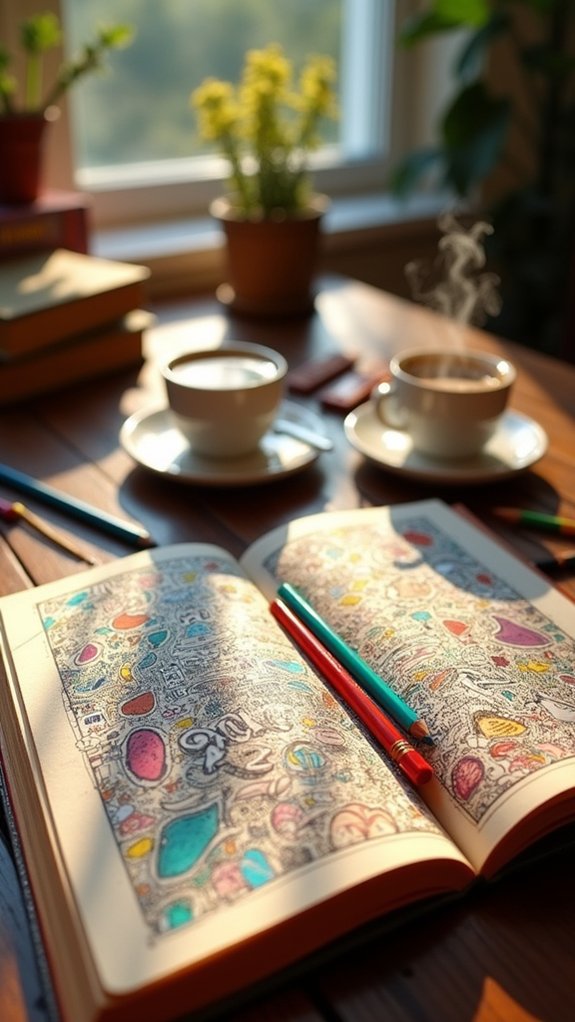
The most powerful art often emerges from the seemingly insignificant moments that fill our daily lives. When artists explore the ordinary through their personal visual lens, they transform mundane moments into art that speaks volumes about human experience.
An art diary becomes the perfect vessel for capturing these fleeting instances—a coffee cup’s shadow, a stranger’s smile, or the way light filters through curtains.
- Look for patterns in your daily routine that might reveal unexpected beauty
- Sketch quick impressions rather than perfect representations
- Combine different media to express how the moment felt, not just how it looked
- Write brief notes beside your visuals to capture thoughts that images alone cannot express
These small practices help artists develop a keen eye for finding extraordinary possibilities in everyday life.
Developing Visual Vocabulary Over Time
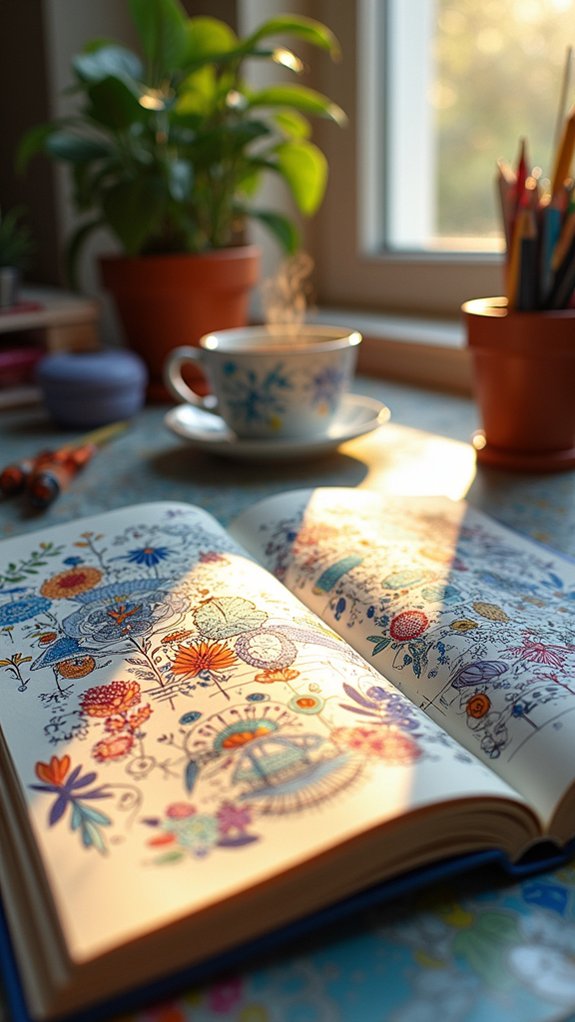
How does an artist develop their unique visual voice? It happens through consistent practice and play with different styles over time.
When artists doodle daily and experiment with new techniques, they build a rich visual vocabulary that speaks their truth without words.
Art journaling becomes a playground where personal symbols emerge naturally. A spiral might represent growth, or a specific shade of blue could express peace. These symbols, born from an artist’s experiences, become like a secret language in their work.
Trying various art forms—from watercolors to mixed media—expands this vocabulary, adding new “words” to express emotions.
Smart artists also look back at their old work, noticing patterns that reveal their authentic style blooming like a garden they’ve been tending all along.
Frequently Asked Questions
Can I Maintain an Art Diary Digitally Instead of on Paper?
Digital art diaries offer flexibility through creative apps, digital tools, and virtual platforms. Many artists maintain digital journals that allow for experimentation, easy sharing, and integration of multimedia elements.
How Do I Handle Mistakes in My Art Diary?
Mistakes foster artistic resilience when embraced. One handles them through acceptance, viewing each error as creative growth opportunity. Digital platforms offer magical undos, while analog methods incorporate mistakes into evolving narratives.
Should I Share My Art Diary Online or Keep It Private?
Sharing artwork involves weighing privacy concerns against potential audience feedback. Many creators find balance by selectively revealing portions of their journals, preserving intimate reflections while still engaging in creative expression online.
How Do Art Diaries Differ From Traditional Sketchbooks or Journals?
Art diaries combine artistic expression with emotional documentation, while traditional sketchbooks focus on technical practice. They chronicle personal growth through visual storytelling and reveal intimate aspects of one’s creative process.
Can Children Benefit From Keeping Art Diaries?
Children indeed benefit from art diaries. They experience creativity boosts through consistent visual experimentation, develop emotional expression skills via symbolic representation, and enhance memory retention by documenting experiences through personalized imagery.
Conclusion
Art diaries aren’t just sketchbooks—they’re personal windows into our lives. Through daily doodles and visual storytelling, anyone can capture emotions, break creative blocks, and transform ordinary moments into something special. The simple act of putting pen to paper builds a unique visual vocabulary that grows with time. Start your art diary today, and watch your creative voice bloom with each page!

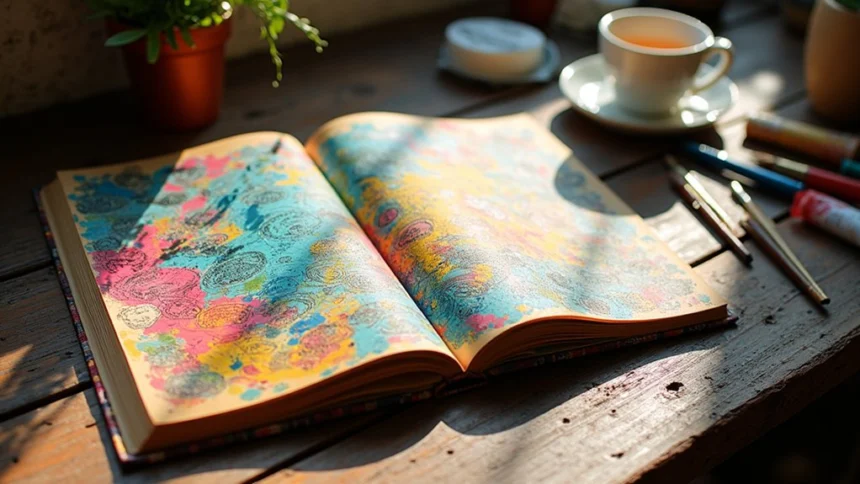
Leave a Reply